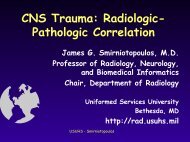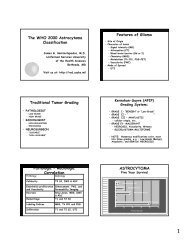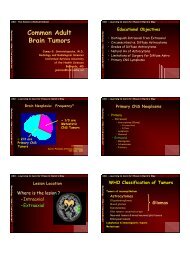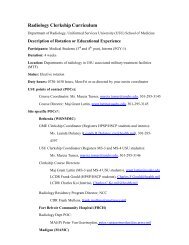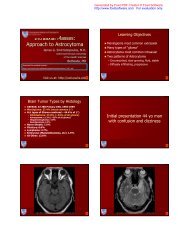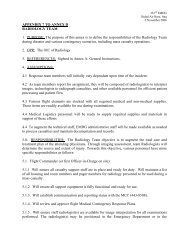MEMORANDUM FOR: RADIOLOGISTS DEPLOYING ... - Radiology
MEMORANDUM FOR: RADIOLOGISTS DEPLOYING ... - Radiology
MEMORANDUM FOR: RADIOLOGISTS DEPLOYING ... - Radiology
You also want an ePaper? Increase the reach of your titles
YUMPU automatically turns print PDFs into web optimized ePapers that Google loves.
(e) The prior radiologists exported /printed this JPTA for ICU portables for techs<br />
(3) There is a meal served starting 0130, recommend eating early (if you can) as the ICU images<br />
start rolling in around 0200. I keep some cereal or other food aside since you often do not get<br />
time to get to the DFAC with ER, traumas, follow-up head CTs, ICU, etc.<br />
(4) Recommend reading ICU 1 first, then delivering those reports, then working your way down<br />
the hall. Hand delivering allows direct feedback to the caring nurse, getting more history,<br />
interaction (plus an opportunity to get up from sitting). Don’t just leave the reports without<br />
handing off to someone and explaining what is going on, especially with positive findings or<br />
tube recommendations.<br />
(5) Before the morning CT follow-ups the flight docs will likely want to go over CT findings on<br />
anything involving closed spaces (sinuses, all head injuries, lung contusions, BLI, etc.). I<br />
found it easier to do a mini-rounds after their first round with JPMRC (Joint Patient<br />
Movement Requirements Center, the ones that tell the flight docs to repeat C-Spines) and<br />
PAD. JPMRC will kickback any spine controversy (why we put “C, T and L spine negative”<br />
in JPTA).<br />
(6) The follow-up head CTs start around 0500.<br />
(7) Morning report (clinical openers): I bring an SOD list of all ED cases/ admits, especially<br />
where imaging effected intervention. Occasionally we help get the imaging results strait, but<br />
the SOD and trauma czar have reviewed fairly completely.<br />
(a) Clinical openers is where you can get a good feel for what other night duties are<br />
important to get the next day started.<br />
(b) This is also where you report any positive TB CXR or CT chest. We had quite a few<br />
during our rotation.<br />
(8) ICU rounds: 0800 or right after morning report in radiologist reading station. I list the ICU<br />
CXR’s I read that night on the SOD sheets in the order I read them. I started by<br />
(9) Nights are a good time to work on LOE and award bullets, SOP, AAR and other<br />
administrative duties.<br />
(10) The quietest time seems to be between 0430 and 0500, I was able to get two 40 minute naps<br />
during the first month (we were relatively slow our first month before the Arrowhead Ripper<br />
Offensive).<br />
(11) The flight commander goes to 2/3’s of the flight commanders meeting (chaired by the<br />
squadron commander) during the entire rotation. During our rotation they were Monday<br />
mornings 9-10. When the flight commander works nights, it was easy to stay an extra hour or<br />
two since they were staying for the clinical openers and ICU rounds.<br />
(a) When the flight commander works days, the night radiologist stays to cover the dept.<br />
(outpatients, ER and trauma codes) while the flight commander goes to the meeting.<br />
(b) Occasionally there are other morning meetings (to provide for those on shifts).<br />
(c) When the flight commander works 3-11, then the night person can go to the meetings<br />
while the day radiologist covers the department. The flight commander can come in early<br />
for late afternoon meetings on that shift.<br />
b) Reporting, outpatients:<br />
i) Keep it simple, I minimize to findings that matter. I discourage reporting on appropriate age<br />
related changes (DJD). I make it known to the ordering providers that I do not report on these<br />
and discourage ordering of LS spine plain CR to R/O DJD, or “scoliosis,” etc.<br />
c) Administrative:<br />
i) Counting: (this is done for monthly exam tracking)<br />
(1) The counting is done by the night shift radiologist for CT and the day R.T. shift leader for<br />
plain film, ER, routine, US. This is recorded in a small green binder by pen/ tickmark.<br />
(2) Documents for entering into XL (from the book) are on<br />
T:\<strong>Radiology</strong>\Rad Numbers\2007\Imaging_Numbers_May-Sept_07<br />
There is also an informative email in the Rad Numbers folder as to the history and<br />
reasoning behind the current counting system.<br />
J:\Projects\Combat <strong>Radiology</strong> Course\SOP August 2007.doc 3




